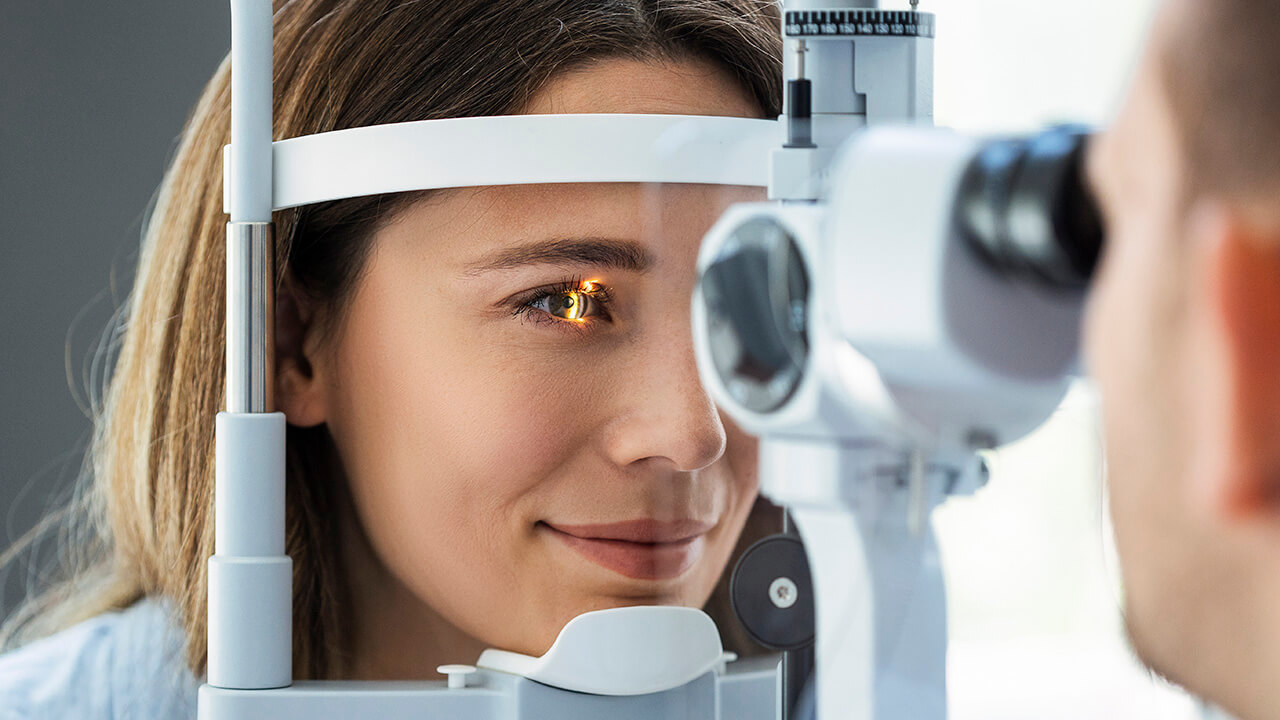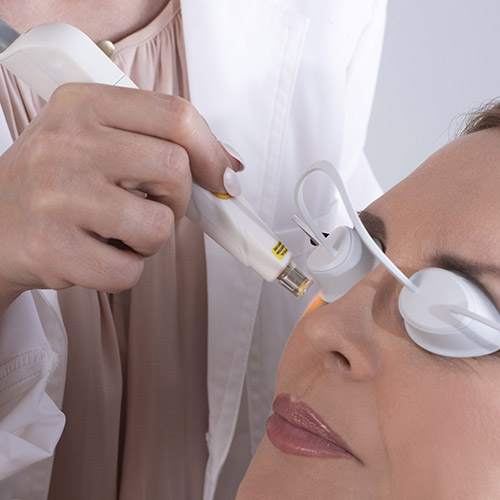

Glaucoma is a disease that damages the eye's optic nerve and can result in vision loss or blindness. A healthy eye has a precise balance between the amount of fluid made in the eye and the amount of fluid that leaves the eye. When more fluid is produced than what is being removed, the balance is thrown off and pressure increases within the eye. Overtime, the pressure transfers to other parts of the eye, including the eye's weakest part - the optic nerve - and glaucoma occurs.
Glaucoma is a long-lasting, permanent condition meaning it does not cause immediate blindness. Unfortunately, there are no symptoms for glaucoma until eye sight is impaired. Some people may miss objects to the side and out of the corner of their eye. They may appear to be looking through a tunnel. Glaucoma patients may also start to see dark patches in their field of vision, growing in size if treatment is not received. Over time, vision may decrease until no vision remains.
Most people who have open-angle glaucoma feel fine, have no eye pain or redness, and do not notice any change in their vision. This is because the initial peripheral (side) vision loss is so gradual that it isn’t noticeable. The sharpness of vision is good until late in the disease. By the time a patient is aware of vision loss, the disease is usually quite advanced. Without proper treatment, glaucoma can lead to blindness.
You’re probably wondering if there is a cure for glaucoma. Unfortunately, there is not. However, if open-angle glaucoma is detected early via regular eye exams, the disease can be slowed. Several treatments, including eye drops, laser treatment and surgery can slow its progression.
Symptoms of angle-closure glaucoma include:
This is an out-patient laser treatment performed at the Prevea Vision clinic. In this surgery a "cold laser" targets the drainage tissue in the eye, stimulating a chemical and biological change that improves fluid drainage and reducing eye pressure. The "cold laser" technology produces less scar tissue and minimal pain which helps to decrease the recovery time. The SLT procedure offers long-term relief from the symptoms of glaucoma, with the effect generally lasting between one to five years. During the relief period many patients no longer need to take glaucoma eye drops. This saves the patient time, money and eliminates the adverse side effects from the drops.
Our eye care providers work with each patient to select treatment options based on type of glaucoma, the patient's needs and the treatments risk and benefits.
Glaucoma is a long-lasting, permanent condition meaning it does not cause immediate blindness. Unfortunately, there are no symptoms for glaucoma until eye sight is impaired. Some people may miss objects to the side and out of the corner of their eye. They may appear to be looking through a tunnel. Glaucoma patients may also start to see dark patches in their field of vision, growing in size if treatment is not received. Over time, vision may decrease until no vision remains.
Advanced technology for early detection
Prevea utilizes the powerful technology of SPECTRALIS® to detect glaucoma and other debilitating eye diseases, such as macular degeneration, in their earliest stages. The SPECTRALIS® exam is performed at the office and usually does not require eye dilation. As the patient sits in a chair, the SPECTRALIS® uses an advanced eye tracking system, to produce detailed 3-D imaging. The 3-D images help reveal eye disease which may not yet be noticeable by the patient or detectable with a traditional visual exam.Risk Factors
- High eye pressure
- 60 years of age or older
- Family history of glaucoma
- African American ethnicity
- Hispanic ethnicity
- Diabetes
There are two types of glaucoma
Open-angle glaucoma
With open-angle glaucoma, there are typically no early warning signs or painful symptoms like that of angle-closure glaucoma.Most people who have open-angle glaucoma feel fine, have no eye pain or redness, and do not notice any change in their vision. This is because the initial peripheral (side) vision loss is so gradual that it isn’t noticeable. The sharpness of vision is good until late in the disease. By the time a patient is aware of vision loss, the disease is usually quite advanced. Without proper treatment, glaucoma can lead to blindness.
You’re probably wondering if there is a cure for glaucoma. Unfortunately, there is not. However, if open-angle glaucoma is detected early via regular eye exams, the disease can be slowed. Several treatments, including eye drops, laser treatment and surgery can slow its progression.
Angle-closure glaucoma
Angle-closure glaucoma is caused by blocked drainage canals in the eye, which result in a sudden rise in eye pressure. This is a much more rare form of glaucoma that develops very quickly and requires immediate medical attention.Symptoms of angle-closure glaucoma include:
- Hazy or blurred vision
- The appearance of rainbow-colored circles around bright lights
- Severe eye and head pain
- Nausea or vomiting (along with severe eye pain)
- Sudden sight loss
Treatment
While there is no cure for glaucoma, early detection and treatment can often protect your eyes against serious vision loss. Medicine, typically administered in the form of daily eye drops, is the most common treatment for glaucoma. If eye drops become a hassle or ineffective, Prevea Vision also offers Selective Laser Trabeculoplasty (SLT) Surgery.This is an out-patient laser treatment performed at the Prevea Vision clinic. In this surgery a "cold laser" targets the drainage tissue in the eye, stimulating a chemical and biological change that improves fluid drainage and reducing eye pressure. The "cold laser" technology produces less scar tissue and minimal pain which helps to decrease the recovery time. The SLT procedure offers long-term relief from the symptoms of glaucoma, with the effect generally lasting between one to five years. During the relief period many patients no longer need to take glaucoma eye drops. This saves the patient time, money and eliminates the adverse side effects from the drops.
Our eye care providers work with each patient to select treatment options based on type of glaucoma, the patient's needs and the treatments risk and benefits.

.jpg?width=500&height=500&ext=.jpg)

